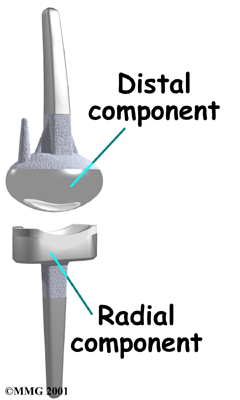Wrist Replacement
Description[edit | edit source]
Wrist replacement, also referred to as wrist arthroplasty is a surgical procedure in which the diseased or damaged joint is replaced with an artificial joint- an implant. It aims to create a stable, pain-free joint with a functional range of movement when conservative treatments have failed.
Total wrist arthroplasty (TWA) is a motion preserving alternative to arthrodesis of the wrist. A wrist replacement usually lasts for about 10 to 15 years. Implant survival of 90-100% at five years are reported in most series - if not all - using newer second generation and third generation implants, but declines from five to eight years.
Total wrist replacements are non weight bearing joints; heavy household or occupational activity, use of a walking aid or repetitive movements e.g. hammering will increase the speed and incidence of loosening of the implants stems and the ultimate failure of the implant. The ideal patient for a TWA should have a low demand lifestyle, should not need the upper extremity for regular ambulation and transfers. Young active patients and individuals with high physical demands are not considered good candidate for TWA.[1][2]
The Artificial Wrist[edit | edit source]
Earlier designs of wrist implants had high complications and failure rates, however, advances in prosthetic design have contributed to improved clinical outcomes and greater implant longevity.[3] The implant is made from metal and plastic and has 2 components- radial and distal component.
The radial component: is the part that fits against the end of the radius bone. It is made up of two pieces- a flat metal piece with a stem that attaches down into the canal of the bone and a plastic cup that fits onto the metal piece, forming a socket for the artificial wrist joint.
The distal component: is the part that replaces the small wrist bones. This piece is made completely of metal. It is globe shaped to fit into the plastic socket on the end of the radius. It is attached by two metal stems that fit into the hollow bone marrow cavities of the carpal and metacarpal bones of the hand.
The prosthesis typically is stable and should demonstrate approximately 350 of flexion and 350 of extension with modest tightness at full extensions.
Indications[edit | edit source]
- Wrist osteoarthritis
- Rheumatoid and non rheumatoid inflammatory arthritis
- Post-traumatic arthritis
- Failed wrist fusion
- Advanced avascular necrosis of the carpal bones
- Kienbock disease
Contra-indications[edit | edit source]
- Severe ligamentous laxity in form of severe volar subluxation
- Highly active synovitis in patients with RA
- Systemic lupus erythematosus
- Patients with minimally functional hand
- Recent infection
- Lack of active wrist extension
Clinical Presentation[edit | edit source]
add text here relating to the clinical presentation of the condition
Diagnostic Tests[edit | edit source]
add text here relating to diagnostic tests for the condition
Pre-Op[edit | edit source]
In patients with rheumatoid arthritis, a comprehensive pre-operative evaluation should be carried out. Prior to wrist arthroplasty, a hip or knee replacement surgery should be carried out to prevent weight bearing on the wrist prosthesis, improve hand balance and optimize rehabilitation of the digits.
Patients for wrist arthroplasty should temporarily discontinue medications such as methotrexate (anti rheumatic) and immune-modulating drugs after consulting with their rheumatologist to reduce the risk of infections and delayed wound healing. NSAIDs should also be reduced at least 10 days pre-operatively and 5 days post-operatively to reduce the risk of bleeding complications.
Radiographic assessment of bone quality, erosions, carpal collapse, carpal ulnar translations, volar subluxation and distal radioulnar joint. In PA view, the radial component should not should not extend beyond the edge of the styloid while the carpal component should not extend > 2mm over the margins of the carpus at osteotomy.
Post-Op[edit | edit source]
add text here relating to post-operative rehabilitation
Key Evidence[edit | edit source]
add text here relating to key evidence with regards to any of the above headings
Resources
[edit | edit source]
add appropriate resources here
Case Studies[edit | edit source]
add links to case studies here (case studies should be added on new pages using the case study template)
References[edit | edit source]
References will automatically be added here, see adding references tutorial.
- ↑ Adams BD. Total wrist arthroplasty. Journal of the American Society for Surgery of the Hand. 2001;1:236-248
- ↑ Adams BD, Khoury JG. Total wrist arthroplasty. In : Weiss APC, Hastings H, eds. Surgery of the Arthritic Hand Wrist. Philadephia, Pa: Lippincott Williams& Wikins; 2002:166-176
- ↑ Kennedy CD, Huang JI Orthop Clin North Am. 2016







